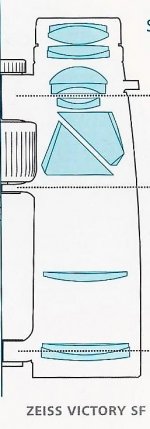Reference Post #20.
When comparing the two binoculars with the SP prisms, it looks like Zeiss reversed the SP prisms on the SF. Also the ocular lens on the SF looks to be very thick with more elements in it when compared to the ocular lenses showing in the other two binoculars pictured in Post #20.
Bob
When comparing the two binoculars with the SP prisms, it looks like Zeiss reversed the SP prisms on the SF. Also the ocular lens on the SF looks to be very thick with more elements in it when compared to the ocular lenses showing in the other two binoculars pictured in Post #20.
Bob






